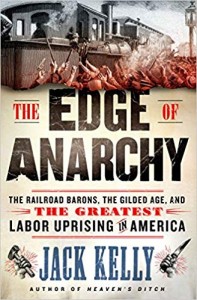The Edge of Anarchy
The Edge of Anarchy: The Railroad Barons, the Gilded Age, and the Greatest Labor Uprising in America
by Jack Kelly (New York: St. Martin’s Press, 2019)
Book Review by Robert D. Parmet, York College of The City University of New York.
In recent years “The Gilded Age” of opulence amidst poverty described by Mark Twain and Charles Dudley Warner in 1873 appeared to be a relic of the past that people of good will would never want repeated. As the twentieth century dawned, America entered the “Progressive Era” and reformed its politics, cleaned up its cities, and put restraints on its business moguls. It was, as historian Richard Hofstadter termed it, an “Age of Reform,” and, in the aftermath of the Second World War, featured unprecedented prosperity. Yet as global economic and political expansion and technological innovation occurred in this age, a “New Gilded Age” appeared, with remarkable resemblance to its forebear, renewing interest in the earlier era. Journalist, novelist and historian Jack Kelly’s The Edge of Anarchy examines its labor struggles, especially in 1894, a truly dreadful year.
Written in a narrative style for a popular audience, without statistical tables or sociological case studies, this book is based on print sources, both primary and secondary, such as works of such authors as Ray Ginger, Stanley Buder, and Nick Salvatore. It is old-fashioned history. Easy reading, it can verge on hyperbole, calling the 1894 Pullman Strike and Boycott America’s “greatest labor uprising.” The nationwide Railway Strike of 1877, which Kelly also discusses, comes to mind as a possible challenger for that honor, as do such other upheavals as the Homestead Lockout of 1892 and Lawrence Textile Strike of 1912. Contrary to some popular belief, American workers were not placid in the late nineteenth and early twentieth centuries.
What Kelly tells is the story of the nationwide boycott of the specially designed railroad cars manufactured by the Pullman Palace Car Company, owned by George M. Pullman, in the town of Pullman, Illinois, near Chicago. Occurring in the midst of an economic depression begun the previous year, the conflict began with the dismissal of Pullman employees, who resided in the company-owned housing under its terms, and then went on strike to protest twenty-five percent wage cuts that were not matched by reductions in the rent they were paying to live there. Led by locomotive fireman Eugene V. Debs, head of the American Railway Union, railroad workers refused to accommodate Pullman cars, thus disrupting travel and transport in twenty-seven states. A federal court injunction ordered an end to the action, citing violation of both the Sherman Antitrust and Interstate Commerce Acts. However, the ARU ignored the injunction, and, prodded by Attorney General Richard C. Olney, a former railroad attorney, President Grover Cleveland sent United States troops to crush the walkout. The basis for this action, which Governor John Peter Altgeld of Illinois called unjustified, was that the strikers were violent and disrupted mail delivery. For violating the injunction, Debs was imprisoned for six months. On his release from jail, he proclaimed himself a socialist, and then proceeded to become a founder of the Socialist Party of America and run five times for president of the United States.
Kelly’s writing is vivid, especially in its depiction of Debs and Pullman. The former he presents as highly thoughtful and very much opposed to violence, not a stereotypical bomb-throwing radical, while Pullman comes across as punctilious and self-absorbed, impervious to compromise. Grover Cleveland appears as incompetent to deal with the economic depression as well as the labor scene, which also included a march for jobs led by businessman Jacob S. Coxey.
A skilled craftsman, Kelly also offers insights into several other areas. He beautifully describes Chicago’s “White City” of 1893 and 1894, the World’s Columbian Exposition, the artificiality of its construction, and its demeaning depiction of Africans as, in Frederick Douglass’s opinion, “savage.” Kelly does note the presence of African Americans in the Pullman workforce, and, interestingly, in Washington, D.C., along with white immigrants. He recognizes the racial discrimination of the 1890s, but is short on detail and Debs’s own views. As for the company town, Kelly devotes a chapter to it and its lord’s “feudalism.”
Kelly concludes his account with a brief chapter, “Solidarity,” in which he attempts to link the past and present gilded ages. He traces the Pullman sleeping car operation to its end in 1981 and beginning of the presidency of Ronald Reagan, and finally comments on the recent sorry state of the American labor movement. Kelly is trying to teach history. The question today is whether the American people are willing to learn it.

